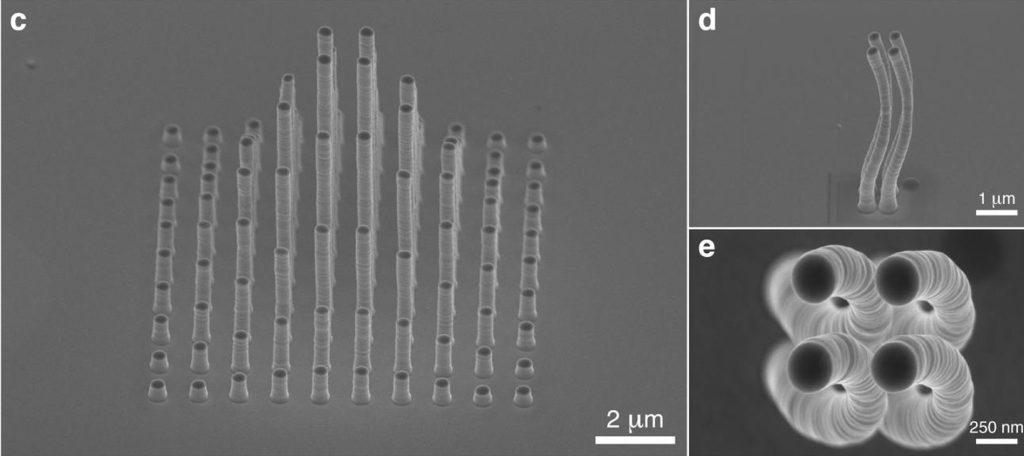China3D printingResearchers at ETH Zurich and Nanyang Technological University (NTU) have developed a new 3D printing technique capable of producing nanoscale metal parts.
Based on electrochemical methods, the process can be used to fabricate copper objects as small as 25 nanometers in diameter. For reference, the average human hair is about 3000 times thicker at 75 microns.
According to the research team led by Dr. Dmitry Momotenko, the new 3D printing technology has potential applications in microelectronics, sensor technology and battery technology.

The new 3D nanoprinting technique works by depositing metal ions onto negatively charged substrates to create tiny metal objects. Image via ETH Zurich.
Adapting Electroplating to Additive Manufacturing
The ETH/NTU nanoprinting method is actually based on the electroplating process, a well-known metal coating technique used in manufacturing. To plate parts, manufacturers suspend positively charged metal ions in a salt solution. A negatively charged electrode is then added to this liquid solution, allowing the ions to combine with the electrons in the electrode and form neutral metal atoms. The atoms are deposited on the electrode as a coating and slowly form a solid layer on the surface.
Momotenko added: “In this process, the solid metal is made from a liquid salt solution — a process that we electrochemists can control very efficiently.”
The nanoprinting process operates on the exact same premise, using a micropipette to deposit positively charged copper ions onto a negatively charged printing surface. In this case, the team used a nozzle tip that is only 1.6 nanometers wide, meaning only two copper ions can pass through at a time. This, combined with several electrochemical printing parameters, allowed the team to closely control the diameter of the printed structures. The paper reports that the smallest printed object is only 25 nanometers wide (195 copper atoms).
On the other hand, conventional powder-based metal 3D printers typically only achieve micron-scale resolution, which is still thousands of times higher than the resolution in current research.
“The technology we’re working on combines two fields – metal printing and nanoscale precision,” explains Momotenko.

This method can be used for vertical, horizontal and oblique printing. Image via ETH Zurich.
MetalNano3D printingApplications
Interestingly, Momotenko’s team found that their 3D printing process was able to create a wide variety of object types, including vertical structures, horizontal structures, obliques and even spirals. This powerful approach is suitable for a range of novel applications, such as more efficient energy storage devices, microelectronics, and even 3D printed catalysts for chemical production purposes.
As for future work, the researchers are currently working on applying the technology to 3D print more compact lithium-ion batteries. These designs feature increased electrode surface area and reduced distance between electrodes, all to speed up the charging process.

SEM imaging of 3D printed copper nanostructures. Image via ETH Zurich.
Research fields often have some of the most innovative 3D printing technologies. Back in October, researchers at Loughborough University developed a novel hybrid 3D printing technique that allows them to change the properties of printed parts over time, enabling new forms of 4D printing. The method, called Material Processing Extrusion Additive Manufacturing (MaTrEx-AM), combines traditional extrusion-based 3D printing with chemical processing.
Elsewhere, at the Fraunhofer IWS, scientists revealed tests of a 3D printing system that could be “a thousand times faster” than current mirror-based laser fabrication techniques. The institute’s setup revolves around a high-power 13 KW “dynamic beam laser” that is said to be able to rapidly generate different energy distribution patterns and precisely print the most demanding materials.
China3D printingNet compilation!
(responsible editor: admin)


0 Comments for “Researchers use new 3D printing technique to make nanoscale metal parts”